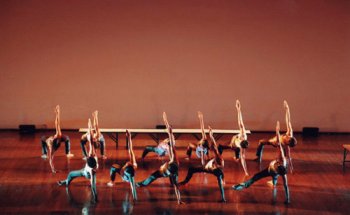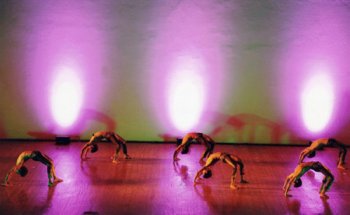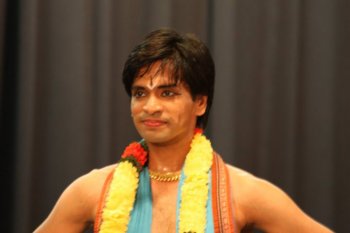
|   |

|   |
Astad, Anita and Aniruddhan! - Lalitha Venkat, Chennai e-mail: lalvenkat@yahoo.com March 10, 2011 Presented by Apollo Children's Hospitals and Astad Deboo Dance Foundation, Astad Deboo and the youngsters from Salaam Balak Trust (a Delhi based NGO dedicated to the welfare of underprivileged youth) enthralled the audience on February 16, 2011at Rukmini Arangham in Chennai with their performance of 'Breaking Boundaries,' a work that premiered in April 2009 at New Delhi. Having worked with Action Players, a group of deaf actors in Kolkata and then dancers of the Clarke School for the Deaf in Chennai, it was a fresh challenge for Astad to work with youngsters who have had no particular dance training and were familiar with only Bollywood style of dancing and for whom Astad's signature style of slow motion gradually moving on in tempo to fast paced chakkars like the whirls of Sufi dervishes, would have been difficult to imbibe and perform in a convincing manner. But strict disciplinarian that he is, Astad achieved the impossible in the course of around six months, exposing them to movements, introducing a few Indian classical mudras, neck movements and lot of floor work, and made them aware that dance can be performed in limited spaces also.   No one watching the one hour show could have guessed that the dancers did not actually know the Bharatanatyam, Kathak or Kathakali vocabulary, or how difficult they must have found to execute the slow motion trademark movements of Astad's style. Sprinkled with acrobatic moves and some yoga stretches, the group was almost poetic in the slow motion movements, and so well synchronized. The music was taken from U Srinivas, Rakesh Chaurasia and Singaporean composer Philip Tan scored the music especially for Astad for the bench and cartwheel numbers. The part where the dancers perform on benches - the contained spaces - dancing in, on and around benches was beautifully and imaginatively choreographed and perfectly executed. Some of the gravity defying moves had the audience holding their breaths! Astad joined the group only in the grand finale sequence, leaving the proud youngsters to enjoy the limelight. The twelve performers were aged between 16 and 26 with Rekha being the youngest and Viraj and Shamshul being the eldest. The others were Neetu, Avinash, Anil, Pankaj, Salim, Raju Thapa, Raju Kumar, Rohit and Gagan. So, what does the ustad of modern dance have to say about his 'Breaking Boundaries'? "As the title suggests, lots of boundaries have been broken. My aim is to show the audience how the dancers have discovered movement and maneuvering movements in limited spaces. Though it was extremely difficult and exacting, no one dropped out and they all took corrections without any objections. They too realized that I was spending so much time to bring them to a standard that could make them proud of their achievements. What is endearing about this group is that they are all so happy to be associated with me and want to continue to work with me - not that the others haven't expressed their desires to continue to work with me!" says Astad Deboo with an endearing smile. The Madras Players, the oldest English theatre group in India, presented 'Karna' to sold out house on March 3, 4 and 5 at the Sivagami Pethachi Auditorium, Chennai. It was nice to see cars parked all long the main road, latecomers scrambling for seats and an entirely different group of people that one does not see at dance performances, all having bought tickets to the show! For most of us, the name Karna conjures up an image of actor Sivaji Ganesan who played the hero in Tamil film 'Karnan' that was released in 1963!  Says director Prasanna Ramaswamy, "With intertextuality as a given premise for my work so far, here I have challenged myself to remain within the realm of the source epic, Mahabaratha, though I have strayed blissfully into allied texts for chants and some interpretational music. Karna's conviction in his ethical stance and his ever present effulgence, despite the betrayals, claimed the centrality of my narration. As always, I have worked with the concepts of the natya tradition, weaving through a tapestry of music and movement as the integral lingo." The story of Karna, the warrior hero who is abandoned by his mother, humiliated by compatriots and betrayed on many a count by many other Mahabaratha characters is a familiar one. Karna is the illegitimate son of Kunti, born (with protective armour and earrings) to her and Sun god Surya before her marriage to Pandu. After birth, Kunti places him in a basket and lets it drift down the Ganges. The baby is found and adopted by charioteer Adhirathan and his wife Radha. He grows up to be a great warrior, but his caste is a slur on his prowess. One's parentage is of great importance and when Karna is insulted at a public archery competition for hailing from a lowly class, the Kaurava King Duryodhana makes him king of one of his lands and calls him the King of Anga. The loyal Karna chooses to fight on Duryodhana's side even when Kunti reveals herself to be his mother and he realizes that the Pandavas are his brothers. The play started with the two drummers Nellai Manikandan and A Shankar walking down the aisle beating the thudumbu and thapam. They positioned themselves on either stage of the stage at ground level. A small dais with steps going down in front of the stage had the actors walking down into the aisle or walking up on to the stage during many moments in the play. Narrators Mala Govias and Nikhila Kesavan filled in parts of the story accompanied by synchronized hand gestures. On either side of the stage, clad in off white silk dhotis and brown short sleeved shirts were singers Swarna Rethas and Sandeep Narayan, who had set the verses from Vyasa Bharatam (located by Prabha Sridevan) to tunes and provided apt vocal accompaniment to the strains of just the sruti box. Kalari movements by A Vasath Kumar and P Jayakumar signified the Kurukshetra war. Seven pretty young dancers, disciples of Anita Guha, played the horses of Surya (TT Srinath). Karna was enacted by PC Ramakrishna and Vidyuth Sreenivasan, with both actors on stage most of the time. The first half had Vidyuth playing the major role and just when one was wondering why PC Ramakrishna's role was so underplayed, the second half had PC in his full form. In the director's vision, the splitting of Karna into two actors allowed her to use one in real time and the other as the voice/conscience/memory of Karna. This device took some time getting used to but was an interesting layering, typical of Prasanna Ramaswamy. Actor Vinod Anand as King Shalya was credible in his satiric mocking of Karna's eagerness to combat Arjuna at war. He gave 'that' look to one who he thinks is of low caste, and forgot to take off that look even when the play ended and the artistes were being introduced! On Krishna's suggestion, the cunning Indra comes in the guise of a Brahmin to disarmour Karna of his protective armour and earrings. Karna is known for his generosity and never says 'No' to anyone asking him for something. The scene shows Karna eagerly offering horses and elephants to the Brahmin who casually turns down all these offers as being of no use to him, but finally accepts Karna's offer of his protective armour and earrings with smug satisfaction. The audience almost told Karna not to part with them! It was a brief role but Mohamed Yusuf as the Brahmin/Indra was very entertaining. The minute Anita Ratnam entered the stage as Kunti, tall and regal in her beautiful costume, a shawl covering her hair, giving us just a glimpse of her face, the audience sat up and took notice. Apart from dance, Anita also has a passion for theatre and is happy to show her acting prowess in some choice plays. Her dialogue delivery as the sad mother who is forced to abandon her baby, as the protective mother who begs Karna not to fight with his brothers, was clear, convincing and very moving. As the only woman character in the entire play, her role was especially significant since it carried shades of pathos and plotting to ensure her sons win the war. The subtle use of dance mudras during her dialogue was also a vivid use of Anita's multiple skills. In conclusion, the house full crowds left with mixed feelings of having relived a beloved epic in a new light.  On March 5, six artistes were featured at Chandramandala for 'Dancers-Separate and Together' presented for the Madras-Chennai Local Festival. The evening included a therukoothu segment by Ashwini Kasi accompanied by her orchestra from Purisai, a short theatrical piece by Srijith Sundaram with film projection and masks, a Bharatanatyam item by Uma Namboodripad, a Mohiniattam item by Maya Vinayan and a lack lustre so-called contemporary piece by Rupesh Reddy. The most interesting was a short theatre piece by Aniruddhan Vasudevan, who chose to portray the Pandava brother Arjuna in his disguise as Brhannala, the dance teacher/eunuch in the court of King Virata, in the well known epic Mahabaratha. While visiting his father Indra in heaven, Arjuna turns down the amorous advances of the nymph Urvasi and she curses him to become a member of the third sex. These men sometimes dressed and behaved as females in Vedic India and had no sexual attraction for women. The five Pandava brothers were exiled from their rightful kingdom for twelve years and a further year had to be spent incognito without detection in the capital city ruled by King Virata. Due to the curse, Arjuna is transformed into Brhannala of the third gender, with the gait of a broad-hipped woman, but still retaining his muscular build. Aniruddh entered wearing a wrap around skirt and traipsed around the stage. Through a perky script, coy female movements alternating with strong male moves, he was entertaining and held the audience attention throughout. Strains of the veena and percussion at appropriate moments provided unobtrusive and apt accompaniment. This is his first presentation of his experimental piece and worth elaborating into a larger presentation. "I had been toying with the idea of working on a piece to do with gender-bending and crossdressing for a while now. The aim was to talk about what such acts of gendercrossing do to one's mind, subjectivity. I also knew I wanted to use Brhannala as a reference point for that. When Madras-Chennai Local asked me to perform a new piece of work, I made that my context! So I worked on a script, subsequently on movements, and developed a basic idea of how I wanted music to work in the piece. I presented it as a work in progress. It seems to have worked! Now I am on to developing it into a longer, much tighter piece. I am excited!" says a happy Aniruddh. Lalitha Venkat is the content editor of narthaki.com |